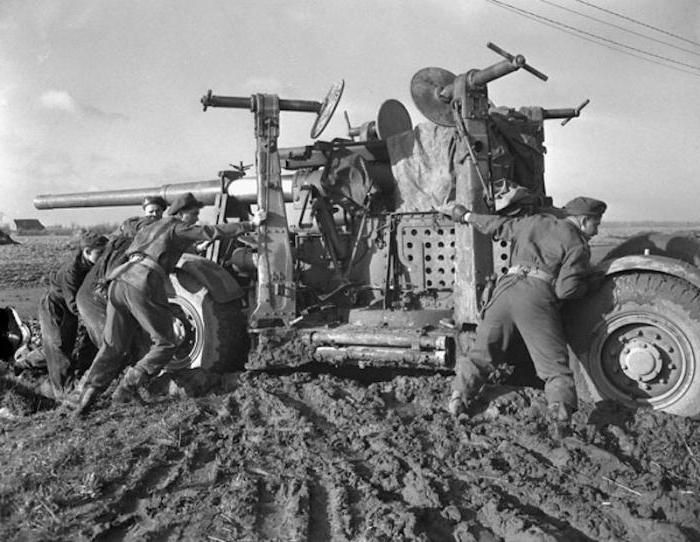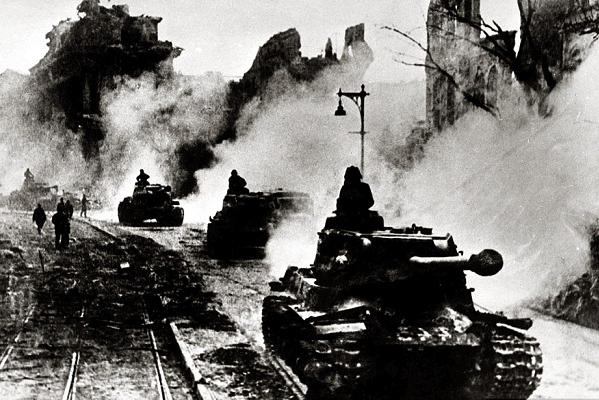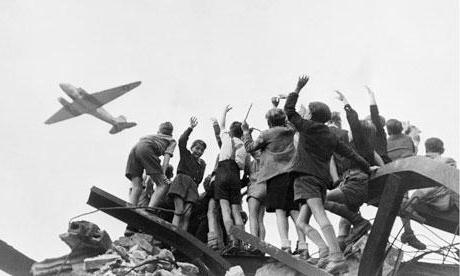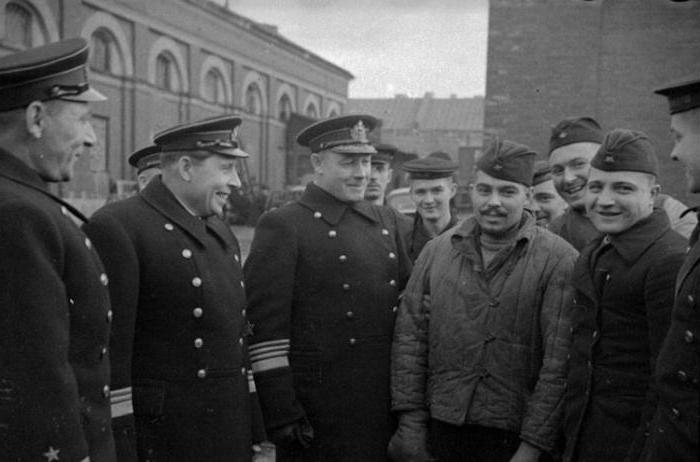2 nd Belorussian Front: Commander, Composition, Battle Route
At the final stage of the Great Patriotic War,when the Soviet troops had already repulsed the entire territory of the RSFSR from the Germans, the 2nd Byelorussian Front was formed. In all, there were two formations of this association, which included several armies.
The first formation
On February 17 at the Headquarters of the Supreme High Commandit was decided to form the 2 nd Belorussian Front. The execution of the decree took place on 24 February. The new front included the army (47th, 61st, 70th), which operated in Polissya, a region on the border between Belarus and Ukraine. Here the Germans retained a strategic advantage, despite considerable defeats in the east. The Wehrmacht soldiers held important cities, which it was not easy to repel. Due to the fact that the strategic initiative in the war finally passed to the USSR, Stalin demanded the maximum acceleration of the offensive, in order to be first in Germany and capture Berlin. However, before setting foot on German soil, Soviet soldiers needed to go through not only Belarus, but also Poland.
The 2nd Belorussian Front was headed by Colonel-GeneralPavel Kurochkin. The chief of staff was Lieutenant-General Vladimir Kolpakchi. It was these people who led the Polesie offensive operation, which lasted from March 15 to April 5, 1944. The main goal of the Soviet armies in this direction was the city of Kovel. Also, the offensive was developing in parallel towards the river Pripyat.

Departure from Kovel
Here there were divisions of German groupings"Center" and "South". A general blow was struck on them, and Soviet troops briefly managed to block Kovel, who nevertheless did not give up. In addition, the Wehrmacht pulled up reserves, which were with the Germans in the rear. The 2nd Belorussian Front has stalled. Soon, there was a noticeable lack of strength, which the Soviet command had nothing to compensate. The reason for this lay in the fact that the GHQ continued to insist on an early offensive, regardless of the state of human resources. The soldiers who were at the front did not leave it for many months and already marched hundreds of kilometers by one march.
Due to the combination of these reasons, the front failedto fulfill its main task - to free Kovel. However, a good reserve was made for the future. The Germans had nothing to counterattack, so for a while the war became positional. On April 5 the 2nd Byelorussian Front was disbanded. Commander Pavel Kurochkin received a new goal.
The Belarusian operation
However, only a few weeks later, 24April, the 2nd Byelorussian Front was formed anew. Its second formation lasted until the very end of the war and was disbanded as early as June 1945. A year before, he had been tasked with finally liberating Belarus.
In May, the front armies fought positionalcharacter, waiting for the order for a new offensive. It began on June 23, when the order to go forward was given to other formations. It was a planned attack by all the Soviet forces that were reorganized after the spring calm and were ready to go ahead again, pursuing the retreating German soldiers.
Not only did the Belarusian operation take partThe 2nd Belorussian Front, but also the 1st Baltic (commander - Ivan Bagramyan), the 3rd Belorussian (commander - Ivan Chernyakhovsky), the 1st Belorussian (Konstantin Rokossovsky). At the beginning of the operation in the Soviet troops were more than one and a half million people, thousands of tanks and artillery pieces.

The Mogilev operation
On the eve of the offensive, the new general headed the Second Byelorussian Front. Commander Ivan Petrov received several armies, including 50th and 4th air.
At the end of June this is a strategic allianceparticipated in the Mogilev operation. During the course of the week, enemy positions were broken through, the Dnieper and Pronya rivers were forced through. Such important cities as Mogilev, Bykhov and Shklov were liberated. Army Group Center received a significant breach, which became its Achilles' heel. On the way of the 2nd Byelorussian Front was the 12th Infantry Division of the Germans, which was completely routed. Also during the air raid the famous commander of one of the tank corps, the Austrian Robert Martinek, died.
At the same time, Colonel-General Georgy FyodorovichZakharov headed the Second Byelorussian Front. The fighting way of this formation ran through dense marshes, in which it was difficult to fight both Germans and Soviet ordinary soldiers.

Bialystok operation
Soon the front armies took part in theBialystok operation, which was an integral part of the Belarusian operation. The new offensive began on July 5, and ended on July 27. That summer, parts of the front closely interacted with the armies of the young general Ivan Danilovich Chernyakhovsky, who tragically died in East Prussia in the last months of the war.
On July 24, the Belarusianthe city of Grodno. Ahead - the border with Poland. There were hundreds of kilometers behind, which the Second Byelorussian Front left behind. The composition of the armies was regularly replenished with new fighters who came from the rear, recovering their wounds or finishing accelerated training courses for fighters. Belarus was cleared of the Wehrmacht.
On July 27, the Soviet Army entered Belostok. This was the first major and important Polish city, which was abandoned by the German interventionists, who came here at the very beginning of World War II, in 1939. With the liberation of Bialystok, the Bialystok operation ended.

East Prussian operation
In November, the head of the front was placed MarshalSoviet Union Constantine Konstantinovich Rokossovsky. At the end of the summer and throughout the autumn, Soviet troops again gained strength in order to make a breakthrough in Poland. In addition, ahead was East Prussia - the German enclave, which already administratively belonged to the Third Reich. Here was the important city of Koenigsberg, as well as the "Wolf's Lair" - the main stake of Adolf Hitler, in which he led the offensive against the Soviet Union, until the situation in the region became absolutely deplorable for the Wehrmacht.
On January 13, the East-Prussian operation began, inwhich took part and the 2nd Belorussian Front. The list of participants in the war is so great that it can not be brought. The names of the heroes were preserved by archival documents. In early 1945, about 1.6 million people took part in the operation.
If the Third Byelorussian Front moved ondirection to Koenigsberg, then the 2 nd went to Marienburg (modern Malbork in Poland). Their concerted actions were to lead to the encirclement of the entire East Prussian group of the Wehrmacht. For the most part, it was the personnel of Army Group Center (in January it was renamed Sever).

Mlavsko-Elbing operation
On January 26, Soviet troops belonging to2nd Byelorussian Front, went to the banks of the Vistula River. Over the past two weeks, the Soviet units successfully completed the Mlawa-Elbing operation. An important bridgehead was also seized in the vicinity of the city of Bromberg. Finally fell Marienburg, which allowed to group forces for an offensive in Pomerania. In the area of the Mazurian Lakes, the Wehrmacht's 2nd Army was surrounded and defeated. The 4th Army also suffered badly.
East Pomeranian operation
From February 10 to April 4, theThe Eastern Pomeranian operation, in which the Second Byelorussian Front took part. 1945 promised to be victorious, but there were still northern Polish provinces, as well as Berlin.
During the first ten days of the offensive by the Sovietthe troops managed to advance only 40 kilometers. Due to large losses and the impossibility of further movement forward, the operation was briefly suspended. On February 24, the 19th Army and the 2nd Shock Army joined the front. Their goal was the city of Keslin (modern Koszalin). The Germans stubbornly resisted, realizing that there was nowhere to retreat by and large.
At the same time, the First Byelorussian Front advancedassistance to the Rokossovsky grouping. The coordinated actions of the two formations made it possible to break through the defense of the German army. It was divided into several small detachments, each of which either retreated, or was surrounded. On March 5, the Soviet units reached the coast of the Baltic Sea. At the end of the month, an important port of Danzig (Gdansk) was captured. The East Pomeranian operation was successfully completed. A major role in this victory was played by the 2nd Belorussian Front. The composition was awarded various medals and orders. Dozens of people were awarded the title of Hero of the Soviet Union.

Berlin operation
There was a decisive battle ahead, although the outcome of the warwas already clear for all parties. The question was only who would be the first to enter Berlin-the army of the USSR or the Western allies. Joseph Vissarionovich Stalin did not want to give way to Churchill and Roosevelt. From all his commanders-in-chief, he demanded to advance at any cost, regardless of the number of those killed. Human sacrifices have become extremely numerous.
Nevertheless, the front was advancing. The Berlin operation began on 16 April. At first, the Oder was forced, which was the natural boundary between Poland and Germany. The Soviet army in a single impulse advanced 200 kilometers, sweeping away the remaining German forces on its way. On Victory Day, May 9, the 19th Army took part in an assault landing on the Danish island of Bornholm. On the whole, the Second Byelorussian Front covered the actions of other formations that directly entered Berlin.

Value
The forces of the 2nd Belorussian Front for the year of theirexistence liberated the whole of Belarus. They defeated the northern Poland from the Germans, having rendered immense help to the local population in its struggle against the interventionists. Finally, the armies entering the front took part in the battle for Berlin. In the summer of 1945, the front was transformed into the Northern Group of Forces, which was in Germany until the collapse of the Soviet Union.








